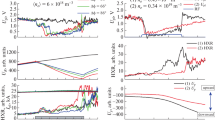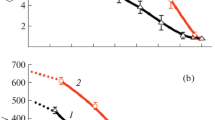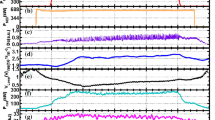Abstract
In experiments on lower hybrid current drive (LHCD) carried out at the FT-2 tokamak, a substantial increase in the central electron temperature T e (r = 0 cm) from 550 to 700 eV was observed. A complex simulation procedure is used to explain a fairly high LHCD efficiency and the observed additional heating, which can be attributed to a transition into the improved core confinement (ICC) mode. For numerical simulations, data obtained in experiments with deuterium plasma at 〈n e 〉 = 1.6 × 1019 m–3 were used. Simulations by the GRILL3D, FRTC, and ASTRA codes have shown that the increase in the density and central temperature is apparently caused by a significant suppression of heat transport in the electron component. The mechanism for transition into the improved confinement mode at r < 3 cm can be associated with the broadening of the plasma current channel due to the lower hybrid drive of the current carried by superthermal and runaway electrons. In this case, the magnetic shear s = (r/q)(dq/dr) in the axial region of the plasma column almost vanishes during the RF pulse. In this study, the effect of lower hybrid waves on the plasma parameters, resulting in a transition into the ICC mode, is considered. New experimental and calculated data are presented that evidence in favor of such a transition. Special attention is paid to the existence of a threshold for the transition into the ICC mode in deuterium plasma.
Similar content being viewed by others
References
Y. Baranov, V. Basiuk, G. Calabro, A. Cardinali, C. Castaldo, R. Cesario, J. Decker, D. Dodt, A. Ekedahl, L. Figini, J. Garcia, G. Giruzzi, J. Hillairet, G. T. Hoang, A. Hubbard, et al., Plasma Phys. Controlled Fusion 52, 124031 (2010).
X. Litaudon, Y. Peysson, T. Aniel, G. Huysmans, F. Imbeaux, E. Joffrin, J. Lasalle, P. Lotte, B. Schunke, J. L. Segui, G. Tresset, and M. Zabiego, Plasma Phys. Controlled Fusion 43, 677 (2001).
T. J. J. Tala, J. A. Heikkinen, V. V. Parail, Y. F. Baranov, and S. J. Karttunen, Plasma Phys. Controlled Fusion 43, 507 (2001).
S. I. Lashkul, A. B. Altukhov, A. D. Gurchenko, V. V. D’yachenko, L. A. Esipov, M. Yu. Kantor, D. V. Kuprienko, M. A. Irzak, A. N. Saveliev, A. V. Sidorov, A. Yu. Stepanov, and S. V. Shatalin, Plasma Phys. Rep. 36, 751 (2010).
S. I. Lashkul, A. B. Altukhov, A. D. Gurchenko, E. Z. Gusakov, V. V. D’yachenko, L. A. Esipov, M. A. Irzak, M. Yu. Kantor, D. V. Kuprienko, A. N. Saveliev, A. Yu. Stepanov, and S. V. Shatalin, Plasma Phys. Rep. 41, 990 (2015).
A. E. Shevelev, E. M. Khilkevitch, S. I. Lashkul, V. V. Rozhdestvensky, A. B. Altukhov, I. N. Chugunov, D. N. Doinikov, L. A. Esipov, D. B. Gin, M. V. Iliasova, V. O. Naidenov, N. S. Nersesyan, I. A. Polunovsky, A. V. Sidorov, and V. G. Kiptily, Nucl. Instrum. Meth. Phys. Res. A 830, 102 (2016).
Y. Peysson and the TORE SUPRA Team, Plasma Phys. Controlled Fusion 42, B87 (2000).
V. Pericoli Ridolfini, G. Calabro, L. Panaccione, FTU team, and ECH team, Nucl. Fusion 45, 1386 (2005).
S. V. Mirnov, Physical Processes in Tokamak Plasmas (Energoatomizdat, Moscow, 1985) [in Russian].
S. I. Lashkul, A. B. Altukhov, V. V. D’yachenko, L. A. Esipov, M. Yu. Kantor, D. V. Kuprienko, A. D. Lebedev, Ya. A. Nikerman, and A. Yu. Popov, Plasma Phys. Rep. 38, 851 (2012).
S. I. Lashkul, A. B. Altukhov, A. D. Gurchenko, E.Z. Gusakov, V. V. Dyachenko, L. A. Esipov, M. Yu. Kantor and D. V. Kouprienko, in Proceedings of the 42nd EPS Conference on Plasma Physics, Lisbon, 2015, ECA 39E, P5.173 (2015).
M. A. Irzak and O. N. Shcherbinin, Nucl. Fusion 35, 1341 (1995).
D. Piliya and A. N. Saveliev, Preprint JET_R(98) 01 (JET Joint Undertaking, Abingdon, 1998).
F. Romanelli and F. Zonca, Phys. Fluids B 5, 4081 (1993).
Author information
Authors and Affiliations
Corresponding author
Additional information
Original Russian Text © S.I. Lashkul, A.B. Altukhov, A.D. Gurchenko, E.Z. Gusakov, V.V. Dyachenko, L.A. Esipov, M.A. Irzak, M.Yu. Kantor, D.V. Kouprienko, A.A. Perevalov, A.N. Saveliev, A.Yu. Stepanov, S.V. Shatalin, 2017, published in Fizika Plazmy, 2017, Vol. 43, No. 7, pp. 593–601.
Rights and permissions
About this article
Cite this article
Lashkul, S.I., Altukhov, A.B., Gurchenko, A.D. et al. Transition into the improved core confinement mode as a possible mechanism for additional electron heating observed in the lower hybrid current drive experiments at the FT-2 tokamak. Plasma Phys. Rep. 43, 711–719 (2017). https://doi.org/10.1134/S1063780X1707008X
Received:
Accepted:
Published:
Issue Date:
DOI: https://doi.org/10.1134/S1063780X1707008X




